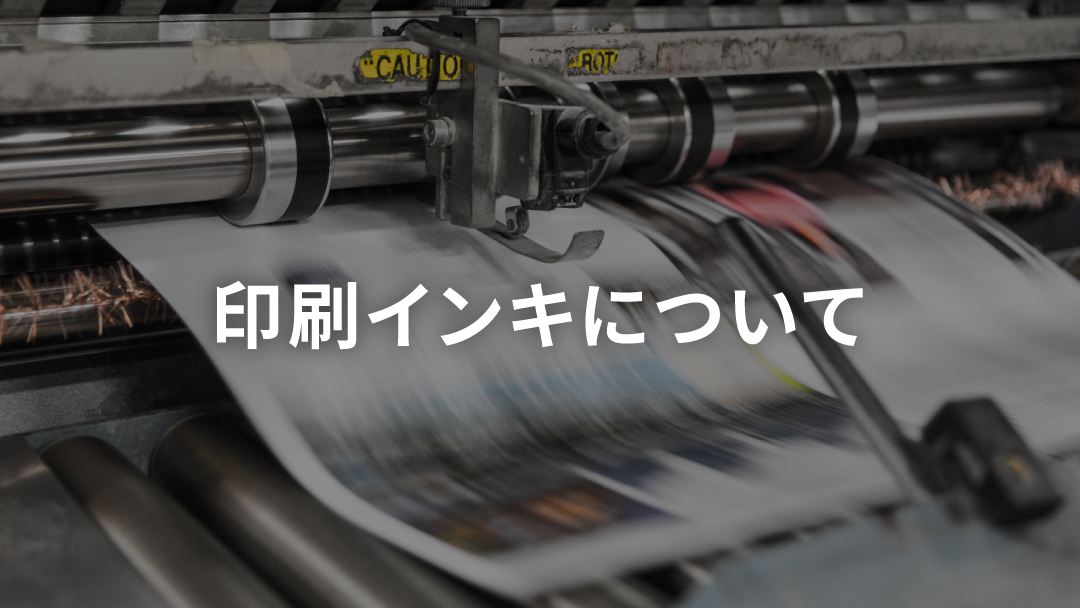お知らせ・お役立ち便覧 NEWS
化学用語解説
2021.11.26
印刷インキについて

目次
ご無沙汰の記事になってしまいましたが、今回は印刷インキについてお話いたします。
印刷インキがどのようなもので、どのような製品に使われているのか、印刷インキと経済活動の関係についても紹介していきます。
文明が発達した現代において、私たちの暮らしと印刷インキは切っても切れない関係にあるといっても過言ではありません。印刷インキを用いた印刷物は文化水準に比例して増えるため、文明度や経済状況の一つのバロメーターともされています。

印刷インキとは
印刷インキとは、文字通り印刷時に用いられるインキのことです。日常生活では「インク」という言葉の方がよく使うので、多くの方は「インキ」という呼び方に馴染みがないかもしれませんがが、印刷業界では「インキ」と呼ぶのが通例です。
印刷インキは数多くの身の回りの製品に使われています。例えば、きっと皆さんが今日手にしたドリンクやお菓子のパッケージや、新聞、お財布に入っている紙幣など、様々なものに印刷インキが用いられています。
印刷物の普及は文明度・経済のバロメーター
日本の近代印刷の歴史を紐解くと、幕末にヨーロッパから活字印刷技術が導入されたことを契機に、明治以降急速に普及していきます。印刷技術により新聞や雑誌、書物などが発行され、近代文明を促進しました。印刷技術の進歩と同時に文化水準が高まり、経済活動も活発化して現代に至ります。
印刷インキは何からできている?
印刷インキの主成分は、次の3つで構成されています。
- 色料
- ビヒクル
- 補助剤
色料とは
色料とは、その名の通りインキに色を与えるものです。印刷物の色表現、インキの流動性、光沢、乾燥性などの性状を決定する役割を担っています。
色料は、顔料と染料に分かれており、顔料は塗料やプラスチック製品などの着色に用いられ、染料は繊維やインクジェットプリンター用のインキなどに使われます。
ビヒクルとは
ビヒクルとは、油脂類・天然樹脂・合成樹脂などを混合した液状成分で、「ワニス」とも呼ばれています。
ビヒクルは英語で「荷車」を意味しますが、顔料を溶解または分散して印刷面まで運び、乾燥固化・固着させるのが主な役割です。
補助剤とは
補助剤とは、滑剤や硬化剤などのことで、インキの流動性や乾燥性などを調整する役割があります。
インキ製造時に少量添加することでインキ調子を変えたり、乾燥性を調整したりと、印刷効果を調整することができます。
印刷インキのタイプと用途
印刷インキは、印刷素材や方法(版式)、機械、後加工の有無などによって、適切な原材料を用います。代表的な版式と、どのような製品に印刷されているのかみていきましょう。
平版インキ(オフセットインキ)
平版(へいはん)インキは、平版印刷で用いられるインキです。インキを紙に転写する方式で、ポスターやカタログ、雑誌、チラシ、書籍、カレンダー、教科書などの印刷に使われています。
ちなみに、紙幣の印刷には平版印刷と凹版(おうはん)印刷の両方が用いられ、精度を維持しています。
樹脂凸版インキ(フレキソインキ)
樹脂凸版(とっぱん)インキは、凸版印刷で用いられるインキです。樹脂版など柔らかい版や凸凹した素材の印刷に向いているため、段ボールや紙袋、包装紙、封筒の他、米袋や紙おむつの外装などのプラスチック包装材にも用いられます。
グラビアインキ
グラビアインキは、凹版印刷の一つであるグラビア印刷時に用いられるインキです。濃度表現を得意としており、菓子袋などの食品容器包装(軟包装)、化粧合板、家具、建材壁紙、携帯電話、自動車の内装などに用いられます。
ちなみに余談ですが、「グラビア」というワードで水着を着たアイドルなどを想像された方も少なくないと思います。グラビアアイドルのグラビアも、グラビア印刷に由来しています。濃度表現が得意なグラビア印刷は、写真の印刷にも適しており、雑誌などの繊細な写真を印刷するのに使われたことから、グラビア雑誌やグラビアページという言葉が生まれました。その後そのようなページをメインに活動するアイドルを「グラビアアイドル」と呼ばれるようになったのです(最近はグラビア印刷ではないグラビアページもあるようです)
スクリーンインキ
スクリーンインキは、メッシュ版を使用する孔版(こうはん)印刷の際に用いられるインキです。
紙だけでなく、金属やガラス、プラスチックや布など、様々なものに印刷でき、かつコップやボトルなどの曲面にも印刷できるため、自動車パネルなどの車両内部部品や、家電製品パネル、CD・DVD、おもちゃ、看板、スマホディスプレイなど幅広い製品に使用されています。
UVインキ
UVインキは、平版印刷や凸版印刷、孔版印刷など、各印刷方式に対応するインキです。大気汚染防止法で排出規制が実施される「揮発性有機化合物(VOC)」が少なく、環境対応型インキとして注目され、溶剤インキからの切替が進んでいます。
特殊機能インキ
特殊機能インキは、平版印刷や凸版印刷の一種であるスクリーン印刷などに用いられます。多岐にわたる機能をもつインキで、印刷時に磁性を与えたり、発光させたり、特殊な効果を加えることができます。インキの使用量こそ少ないものの、液晶テレビや電子基板に利用されています。
新聞インキ
新聞インキは、平版印刷で作成される新聞の印刷に用いられるインキです。圧倒的な印刷スピードに耐えられるインキで、新聞だけでなく広報誌などにも使われています。
新聞インキや平版インキのほとんどで大豆油を使った大豆インキが使われていましたが、近年では食用穀物確保の観点から、大豆油以外の食物油インキの拡大が推進され始めています。
併せて読んでほしい!
印刷方法の種類について動画で解説!
印刷の種類
印刷インキと洗浄
印刷インキを洗浄するには、有機溶剤系の洗浄剤が使用されます。かつて印刷インキの会社で、ジクロロメタン(別名:塩化メチレン、メチレンクロライド)をはじめとした発がん性のある有機溶剤を使用していたことにより、胆管がんによる死者がでました。
それ以来、印刷業界では有害性の低い洗浄剤の採用や、有機溶剤を使用する際の蒸気対策が徹底されるようになりました。
有害性の低い洗浄剤とは、有機溶剤中毒予防規則や特定化学物質障害予防規則に非該当の洗浄剤のことです。
ちょこっと販促!
三協化学製 有機則・特化則非該当の印刷インキ洗浄剤
印刷と経済活動の関係
デジタル化やスマートフォンの普及による新聞発行部数減少などの要因で、出版用インキの生産量・出荷量、出荷金額は年々減っています。また、新型コロナウイルスの影響でイベント用の印刷物や広告が減少し、企業規模を問わずインキメーカーの業績は落ち込みました。
しかし一方で、環境調和型のUVインキや、新興国を中心とした食品包装などに用いられる軟包装用インキの需要が高まっています。

総合マーケティングビジネスの株式会社富士経済が実施した「2020機能性インキ市場の全貌」の調査によると、2023年の機能性インキの世界市場は拡大すると予測されています。コロナ前の2019年比でUVインキが16.7%増、軟包装用インキは同10.6%増の見込みです。 今後の印刷インキ市場拡大には、暮らしの豊かさに加え、より一層の環境負荷低減が求められるでしょう。
出典
2020 機能性インキ市場の全貌 | 調査レポート | 富士経済グループ
機能性インキの世界市場を調査|Fuji Keizai Groupプレスリリース
参考サイト
カテゴリーから探す
キーワードから探す